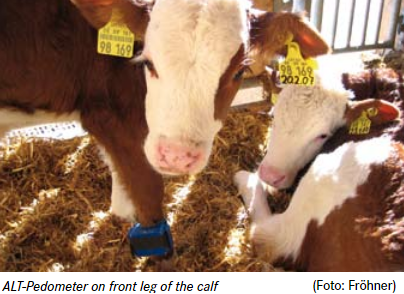Sick calves lie down a lot and drink or eat less than their healthy peers. Therefore, calf activity can be used as a parameter for early detection of calf diseases. Furthermore, play behaviour indicates positive emotions and can thus be used to assess "animal welfare".
The problem here is that behavioural observation can be tedious and labour-intensive. Therefore, such behaviours will rarely find their way into an animal welfare assessment protocol. And they will also be neglected from time to time in the stressful daily routine of the farm. With pedometers, however, a possibility for automation was tested and found.
In comparison with video evaluation, it was shown that the play behaviour of up to 48-hour-old dairy calves can be detected via pedometers (Gladden et al. 2020). In another study it was shown that low activity or increased lying down of calves can be detected by pedometers and used for early detection of respiratory diseases (Duthie et al. 2021). Fröhner, A. et al. (2011) also emphasizes the usefulness of pedometers in health monitoring of calves, but clearly points out that this aid can only support visual animal observation. Because there are considerable differences in activity between animals.
 Source: Fröhner, A. et al. 2011
Source: Fröhner, A. et al. 2011
Even if the monitoring with pedometers is not necessarily something for practical use, these findings give an important impetus for animal control. Take the time to observe the behaviour of the calves and detect problems at an early stage!
Literature:
- Duthie, C.-A. et al. (2021): Feeding behaviour and activity as early indicators of disease in pre-weaned dairy calves. Animal 15 (2021) 100150 https://doi.org/10.1016/j.animal.2020.100150
- Gladden, N. et al. (2020): Use of tri-axial accelerometer can reliably detect play behavior in newborn calves. Animals 2020, 10, 1137; https://doi.org/10.3390/ani10071137
- Fröhner, A. et al. (2011): Früherkennung von Erkrankungen bei Kälbern unter Nutzung pedometergestützter Messtechnik. Landtechnik 66 (2011), no. 6, pp. 448–452 https://www.landtechnik-online.eu/landtechnik/article/view/2011-66-6-448-452/2011-66-6-448-452-de-pdf
This Innovation has an impact on:
- Socioeconomic resilience: The use of pedometers increases the cost for equipment and thus has an impact here.
- Animal health and welfare: The early detection and early treatment of impaired calves increases health and welfare.
- Production efficiency and meat quality: Average daily growth is higher in healthy calves and therefore production efficiency can get influenced by the use of pedometers.
- Environmental sustainability: Feed efficiency is higher in healthy calves.